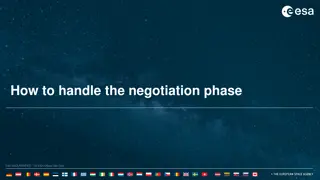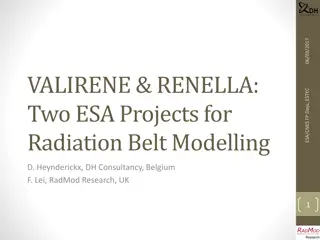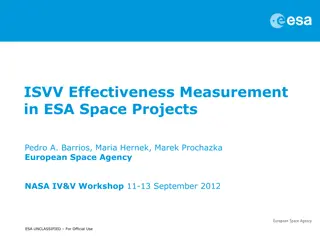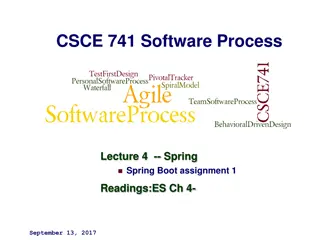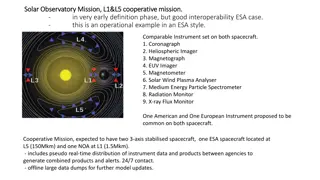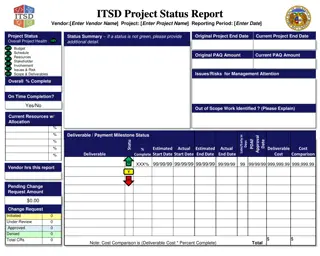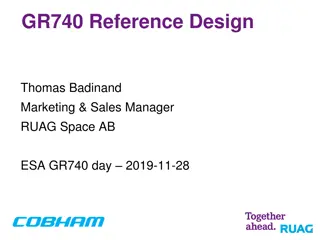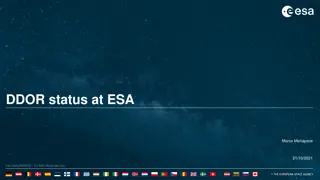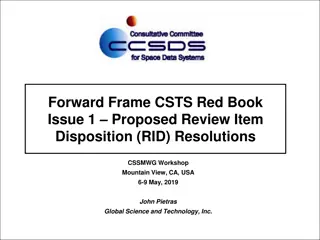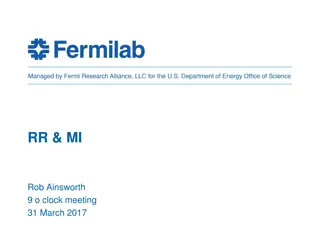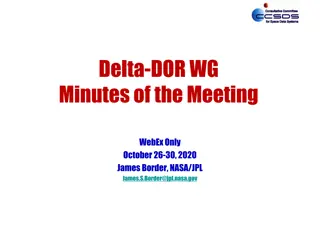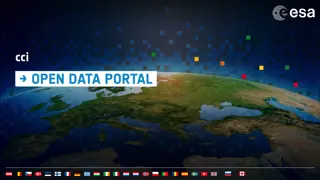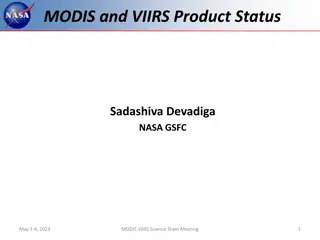Current ESA Activities and DDOR Status Updates for Spring 2023
ESA provides updates on current activities including GAIA, BepiColombo, Solar Orbiter, JUICE, PN DOR Correlator software testing, Lunar Flashlight validation, and TTCP upgrades. The DDOR status at ESA for Spring 2023 involves operational supports in 4Q2023. Additionally, insights on ESA-JAXA cross-support validation, quasar histogram issues, DART results from JPL, and more are detailed in the updates.
Download Presentation

Please find below an Image/Link to download the presentation.
The content on the website is provided AS IS for your information and personal use only. It may not be sold, licensed, or shared on other websites without obtaining consent from the author. Download presentation by click this link. If you encounter any issues during the download, it is possible that the publisher has removed the file from their server.
E N D
Presentation Transcript
DDOR status at ESA Spring 2023 Marco Menapace, Javier de Vicente May 2023 1 ESA UNCLASSIFIED For ESA Official Use Only
Current ESA activities GAIA BepiColombo Mercury swing-by in May-June 2023 ESA-JAXA Cross-support validation? Solar Orbiter Following Venus swing-by #3 (July-September 22), no need for DDOR supports at the moment JUICE DDOR Commissioning tests (TBC date) Operational supports in 4Q2023 2
Current ESA activities PN DOR Correlator software to support REC 2.5.7B under testing Despreading functionality Quasar-like correlation IDST validation in ESOC lab concluded Lunar Flashlight: First validation of ESA correlator for flying spacecraft data - Ongoing TTCP upgrades on open loop gain: Independent gain between carrier channel and other channels has now been implemented Gain resolution fix (better than current 6 dB, see next slide) expected shortly 3
ESA-JPL flux comparison (from Fall21 and Spring22, not closed) Background: Different estimated flux on same passes (same baseline, TTCP vs POLR) Quasar Histogram on TTCP is sometimes wrong (too few -3 and +3) The reason might be a wrong automatic gain configuration, resulting in saturation Gain resolution is 6 dB, a small difference in input power estimation can have big effect on the histogram DART data have highlighted correlation between lower flux and wrong histogram This confirms that the discrepancy in flux estimation can depend on the gain resolution issue TTCP upgrade regarding gain (see previous slide) could improve this aspect 4
DART results from JPL DoY 187 Quasar SNRs Scan 1 and Scan 7 are affected on TTCP1, but not on TTCP2 5
DART results from JPL Quasar Histogram (Scan 1) The histogram related to the affected Scan (scan 1 on TTCP1) is not correct 6
DART results from JPL Quasar Histogram (Scan 3) The histograms with the correct SNR estimation have a consistent histogram 7
ESA-JAXA cross-support validation (from Fall21 and Spring22, not closed) Background: Three Bepi Colombo passes were supported by JAXA in Usuda and Misasa Results not completely conclusive, as reported in Fall21 meeting JAXA results still awaited New pass opportunities to be discussed This topic could become critical if operational passes with ESA-JAXA mixed baseline are foreseen in the next future 8
Upcoming ESA DDOR work TTCP gain resolution fix and validation Integration of various PN DOR building blocks (e.g. despreading, correlation) on correlator HERA (PN DOR) preparations Radio Frequency Compatibility Testing(RFCT) in 4Q2023 Launch in 2024 Automation of mixed baseline correlations 9
Future cross-support activities PN DOR tests with Lunar Flashlight First step: Correlation of data recorded with NASA baselines Second step: Mixed NASA-ESA baseline? ESA-JPL test following gain resolution fix on TTCP Completion of ESA-JAXA validation 10







